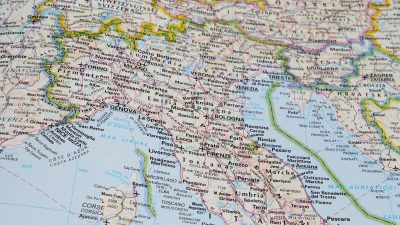Unseen Destruction, Lingering Consequences, And Lessons In Resilience
On March 5, 1987, a massive earthquake of magnitude 7.9 struck Ecuador, leaving widespread destruction in its wake. The hardest-hit areas were along the coastal region, with cities like Guayaquil experiencing catastrophic damage. Buildings collapsed, roads fractured, and thousands of people lost their lives. This devastating event forced Ecuador to rethink its approach to disaster management and preparedness, and its effects are still seen in the country today.
Beyond the physical destruction, the earthquake brought about significant social changes. It highlighted the lack of preparedness in the face of such a powerful natural disaster. Over 1,000 lives were lost, and many more were injured or displaced. The long recovery process would require resilience from both the government and the people of Ecuador, as the nation sought to rebuild and recover from the immense tragedy.
The Hidden Realities of the 1987 Ecuador Earthquake Disaster
While the 1987 earthquake was a well-known catastrophe, there were lesser-known aspects that emerged in its aftermath. Ecuador, like many countries, was unprepared for such a large-scale disaster, and its initial response was slower than needed. Emergency services were overwhelmed, and the country struggled to mobilise resources. This slow reaction led to even more devastation in the affected regions.
In addition, international aid played a crucial role in Ecuador’s recovery. Countries around the world offered financial support, medical aid, and rescue teams to help the nation in its time of need. However, logistical challenges meant that much of the aid did not reach the worst-hit areas immediately, causing frustration and inefficiency. Despite these issues, Ecuador’s eventual recovery was bolstered by both national and international efforts to rebuild.
The True Cost of the 1987 Ecuador Earthquake
- Economic Toll: The earthquake caused severe economic damage, with billions of dollars in losses. Vital infrastructure was destroyed, including roads, bridges, and buildings, disrupting trade and local economies. Rebuilding this infrastructure took years, and Ecuador faced financial strain as a result.
- Loss of Life: More than 1,000 people were killed in the disaster, with countless others injured. The human cost was immense, with entire families torn apart. The emotional and psychological toll on the survivors was also profound, as many had to rebuild their lives from scratch.
- Impact on Livelihoods: Ecuador’s agricultural sector, which many people depended on, was severely affected. Farmlands were destroyed, and farmers lost their livelihoods. Rebuilding the agricultural economy was a significant part of Ecuador’s recovery, taking years to restore the agricultural output.
The Overlooked Consequences of the 1987 Ecuador Earthquake
The effects of the 1987 Ecuador earthquake went far beyond the initial destruction. In the years following the quake, survivors faced numerous challenges in rebuilding their lives. Many were displaced and had to live in temporary shelters for long periods. The lack of basic necessities such as food, water, and medical supplies created a constant struggle for many Ecuadorians.
The earthquake also had significant psychological impacts. Many survivors experienced trauma, anxiety, and depression in the aftermath of the quake. These mental health effects, though not always visible, have lingered over the years, as many people continue to deal with the emotional scars left by the disaster.
Why the 1987 Ecuador Earthquake Was More Devastating Than Expected
- Unexpected Intensity: Though Ecuador is located in a seismically active zone, the intensity of the 1987 earthquake took many by surprise. The earthquake was much more powerful than what most people were prepared for, leading to widespread devastation.
- Absence of Early Warning Systems: In 1987, Ecuador lacked the sophisticated seismic warning systems that we rely on today. This left people with little time to evacuate or take protective measures, making the impact of the earthquake even worse.
- Inadequate Building Regulations: One of the primary reasons for the devastation was the lack of enforcement of strict building codes. Many buildings in the affected areas were not designed to withstand such strong tremors, leading to their collapse and contributing to the high death toll.
The Aftermath of the 1987 Ecuador Earthquake: Was the Response Sufficient?
- Government Action: Following the earthquake, the Ecuadorian government took steps to coordinate relief efforts. However, the response was initially slower than needed, as many regions remained cut off for days due to damaged infrastructure. The government worked alongside international aid agencies to address the needs of the affected people.
- Global Support: International organisations and governments provided financial assistance, medical teams, and supplies to Ecuador. Despite some logistical challenges that delayed aid distribution, the international response was crucial in helping Ecuador recover.
- Key Takeaways: The earthquake sparked changes in how Ecuador prepares for disasters. The nation adopted stricter building codes, improved early warning systems, and enhanced its emergency response strategies to better handle future events.
Could the 1987 Ecuador Earthquake Have Been Prevented? The Startling Facts
- Seismic Risk: Ecuador lies within the Pacific Ring of Fire, making it prone to earthquakes. While the event could not have been prevented, its impact could have been reduced with better preparedness and risk mitigation strategies.
- Weak Infrastructure: The destruction caused by the earthquake was largely due to the poor construction standards in many areas. Had stricter regulations been in place, the loss of life and damage could have been much lower.
- Technological Gaps: In 1987, Ecuador did not have access to modern earthquake prediction technologies. Today’s advanced seismic sensors and early warning systems could have given residents more time to prepare and evacuate.
When Earthquake Strikes: How the 1987 Ecuador Earthquake Exposed Our Vulnerabilities
- Infrastructure Failures: The 1987 earthquake exposed the vulnerability of Ecuador’s infrastructure. Roads, bridges, and buildings were not built to withstand such powerful earthquakes, highlighting the need for improved construction standards in seismically active areas.
- Human Vulnerability: The disaster revealed how susceptible humans are to the effects of natural disasters. People living in poverty or substandard housing were disproportionately affected, underlining the importance of addressing social inequalities in disaster preparedness.
- Geological Insights: The earthquake also underscored the importance of studying the geological factors that contribute to seismic activity. Ecuador has since prioritised research into tectonic plate movements and how they can affect nearby populations.
Conclusion
The Lasting Legacy of the 1987 Ecuador Earthquake: Lessons in Resilience
The 1987 earthquake left a profound mark on Ecuador, but it also sparked positive changes in disaster preparedness. The nation learned valuable lessons in the aftermath, including the importance of building resilient infrastructure and preparing for future seismic events. Ecuador’s ability to recover from such a catastrophic event serves as an example for other countries vulnerable to natural disasters.
5 Short FAQs
- What caused the 1987 Ecuador earthquake?
- The earthquake was caused by tectonic shifts along the boundary between the Nazca and South American plates, a common source of seismic activity in the region.
- How many people died in the 1987 Ecuador earthquake?
- Over 1,000 lives were lost, with many more injured or displaced in what was one of the most destructive earthquakes in Ecuador’s history.
- What was the economic impact of the 1987 Ecuador earthquake?
- The earthquake caused billions in damage, disrupting vital infrastructure, agriculture, and commerce, leading to long-term economic challenges.
- How did the government respond to the 1987 Ecuador earthquake?
- The government coordinated rescue efforts and received international aid, though the initial response was hindered by logistical challenges and the scale of destruction.
- Has Ecuador made progress in earthquake preparedness since 1987?
- Yes, stricter building codes, better early warning systems, and improved disaster response strategies have been implemented to mitigate future risks.
References:
“The March 5, 1987, Ecuador Earthquakes: Mass Wasting and Socioeconomic Effects”
“Mass Wasting Triggered by the 5 March 1987 Ecuador Earthquakes”
“1987 Ecuador Earthquakes”
“Quito Earthquake Risk Management Plan”




